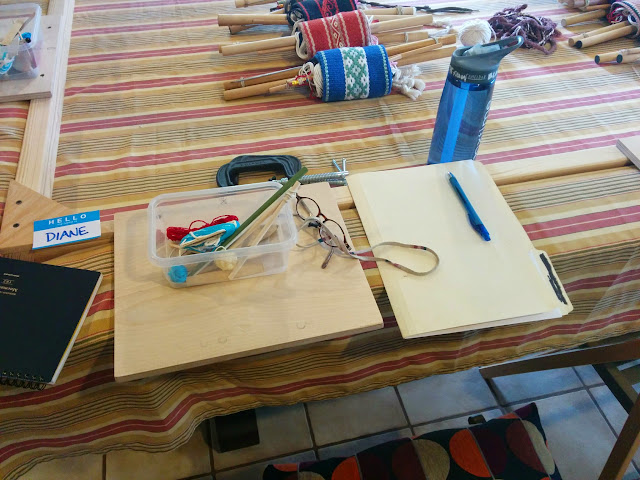I spent most of last week back in Wisconsin helping my brother go through my dad’s house. He turned 90 a few weeks ago and his health isn’t as good as it was, so he’s moved into a senior living center and would like us to sell the house. We spent three solid days going through paperwork, clothes, art. Memories both happy and sad abound in that house and it was both physically and emotionally exhausting. I took very little with me – I’d already purged a lot when we moved to California nearly 20 years ago so it was more of a chance to identify those few things that would remind me of home and family. After a week of sorting I was more than ready for something entirely different.

Nothing is more wonderful than class supplies all lined up and ready to go. It’s potential energy embodied. This is what my little workstation looked like on Saturday morning while I (im)patiently waited for Laverne Waddington to school me in the basics of backstrap weaving. I’d passed up two earlier opportunities to take Laverne’s class because I still had so many other things to pursue but now I’m at a point where making cloth in this way is important. The portability of everything is a big point in it’s favor – as well as learning yet another way to make durable, gorgeous narrow-wares.
Another point in Laverne’s favor is the evidence of her knowledge and experience. I’m kicking myself for not taking pictures of her samples (she was happy to have us do so), but it’s all there on her blog. And she’s also taken a decidedly non-traditional approach to this craft. She’s studied all over South and Central America, as well as Asia, and has combined what she thinks are the best of all the techniques when she weaves and teaches. Her piles and piles of pieces, both large and small, are quite persuasive. She also does a tremendous amount of preparation on her students’ behalf – there were three warps pre-wound and ready to go for each of us (there were eight in the class) and she brought everything we’d need to get through the two days. Each of those warps came home with us, along with two more that we wound ourselves, so we’d have plenty of opportunity to practice.
First off was basic weaving. We started in the same place young children do – the backstrap equivalent of plain weave so that we could get used to the motions and feel of the process.

With no equipment other than a few pieces of string, we were making little bands. Getting a feel for the right amount of tension and working with us as the loom was the goal. Being able to weave this little band set us up to move on to something a bit more challenging after lunch – a wider warp and using a proper backstrap for supplemental weft inlay:

The time I’d been spending with inkle and tablet weaving helped me to get my head around this pretty quickly. Again, super-chunky yarn (close to a worsted-weight knitting cotton) so that there was plenty of room to work the patterns and using eight strands of 8/2 tencel as the supplemental weft. I really, REALLY loved this. Laverne had many pieces that were much finer and done in silk. Lots of opportunity here to do some interesting work but not get twitchy about the length of those floats! At the end of day one, we each wound a warp of a finer cotton and then added heddles and a rolling stick so that we’d be ready to practice the same technique at home.
Day two we then moved on to our next technique – pickup. Once again a pre-wound warp was waiting for us, but we had to complete the set-up on our own – which included tying string heddles and moving the cross. After a false start which included dropping and re-picking my cross, I got started with plain weave:

And then, after much fiddling, I made my first group of tanka ch’oro.

Fabulous! These little guys are all over my Peruvian bags – and now I can make them, too. Haltingly, not perfect, but nevertheless. Me and my chunky cotton are on our way. We then wound our own two-color warps for practice and reference and then it was time to head home.
All in all, a very pleasant and instructive weekend. Lots of things rolling around in my head – and I’m finding similarities between techniques and equipment all over the place. The live-tension (literally!) of backstrap made it’s way to my tablet loom and it’s right there on the AVL. Thread management is what weaving is all about. Once that’s down, we get to make beautiful cloth. I’m already looking forward to my next class with her in October. And I’m determined to have samples to prove that I’ve been practicing.
